
Aechmea angustifolia is a plant species in the genus Aechmea. This species is native to Central America and northern South America.

Aechmea mertensii is a plant species in the genus Aechmea. This species is native to Bolivia, Brazil, Colombia, Ecuador, Guyana, French Guiana, Peru, Suriname, and Venezuela.
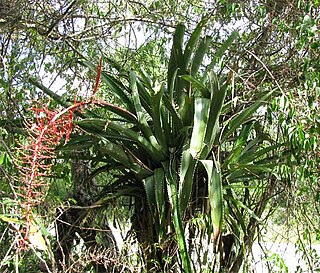
Aechmea bracteata is a plant species in the genus Aechmea. This species is native to Central America, Mexico, Colombia, and Venezuela; it is also reportedly naturalized in the Bahamas.

Aechmea mexicana is a plant species in the genus Aechmea. This species is native to central and southern Mexico, Central America, Colombia and Ecuador.
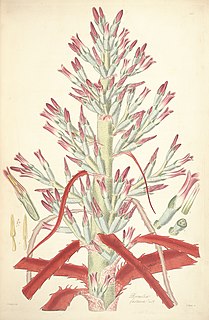
Bromelia pinguin is a plant species in the genus Bromelia. This species is native to Central America, Mexico, the West Indies and northern South America. It is also reportedly naturalized in Florida. It is very common in Jamaica, where it is planted as a fence around pasture lands, on account of its prickly leaves. The plant can be stripped of its pulp, soaked in water, and beaten with a wooden mallet, and it yields a fiber whence thread is made. In Nicaragua and El Salvador it is used to make gruel.
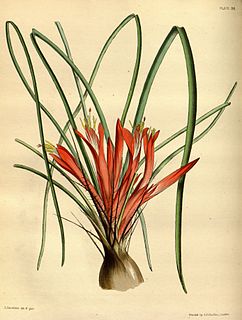
Pitcairnia heterophylla is a plant species in the genus Pitcairnia. This species is native to northern South America, Central America, and central and southern Mexico.
Werauhia hygrometrica is a species of flowering plant in the Bromeliaceae family. It is native to Costa Rica, Mexico, Venezuela and Ecuador.
Aechmea corymbosa is a plant species in the genus Aechmea. This species is native to Venezuela, Colombia, Peru, Brazil and Ecuador.

Aechmea dactylina is a plant species in the genus Aechmea. This species is native to Costa Rica, Nicaragua, Panama, Colombia and Ecuador.

Aechmea longifolia is a species in the genus Aechmea. This species is native to Bolivia, Venezuela, Colombia, the Guianas, northern Brazil, Peru and Ecuador.

Aechmea penduliflora is a species of flowering plant in the Bromeliaceae family. It is native to Central America and northern South America.
Aechmea pyramidalis is a plant species in the genus Aechmea. This species is native to Ecuador, Colombia and Peru.
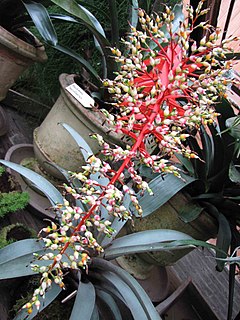
Aechmea servitensis is a species of flowering plant in the Bromeliaceae family. It is native to Ecuador and Colombia.

Aechmea setigera is a plant species in the genus Aechmea. This species is native to Bolivia, Venezuela, Colombia, Panama, Suriname, French Guiana, Ecuador, and northern Brazil.
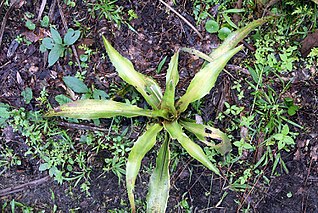
Aechmea veitchii is a plant species in the genus Aechmea. This species is native to Costa Rica, Panama, Colombia, Peru, and Ecuador.
Greigia columbiana is a plant species in the genus Greigia. This species is native to Costa Rica, Panama, Colombia, Ecuador, and Venezuela.

Guzmania coriostachya is a plant species in the genus Guzmania, and is native to Costa Rica, Panama, Colombia, Venezuela and Ecuador.
Pitcairnia arcuata is a flowering plant in the Bromeliaceae family. It is native to Costa Rica, Panama, Colombia, Peru, and Ecuador.

Aechmea tocantina is a species of flowering plant in the Bromeliaceae family. This species is native to northern and central South America.
Aechmea tonduzii is a plant species in the genus Aechmea. This species is native to Costa Rica, Panama, Colombia, and Ecuador.














